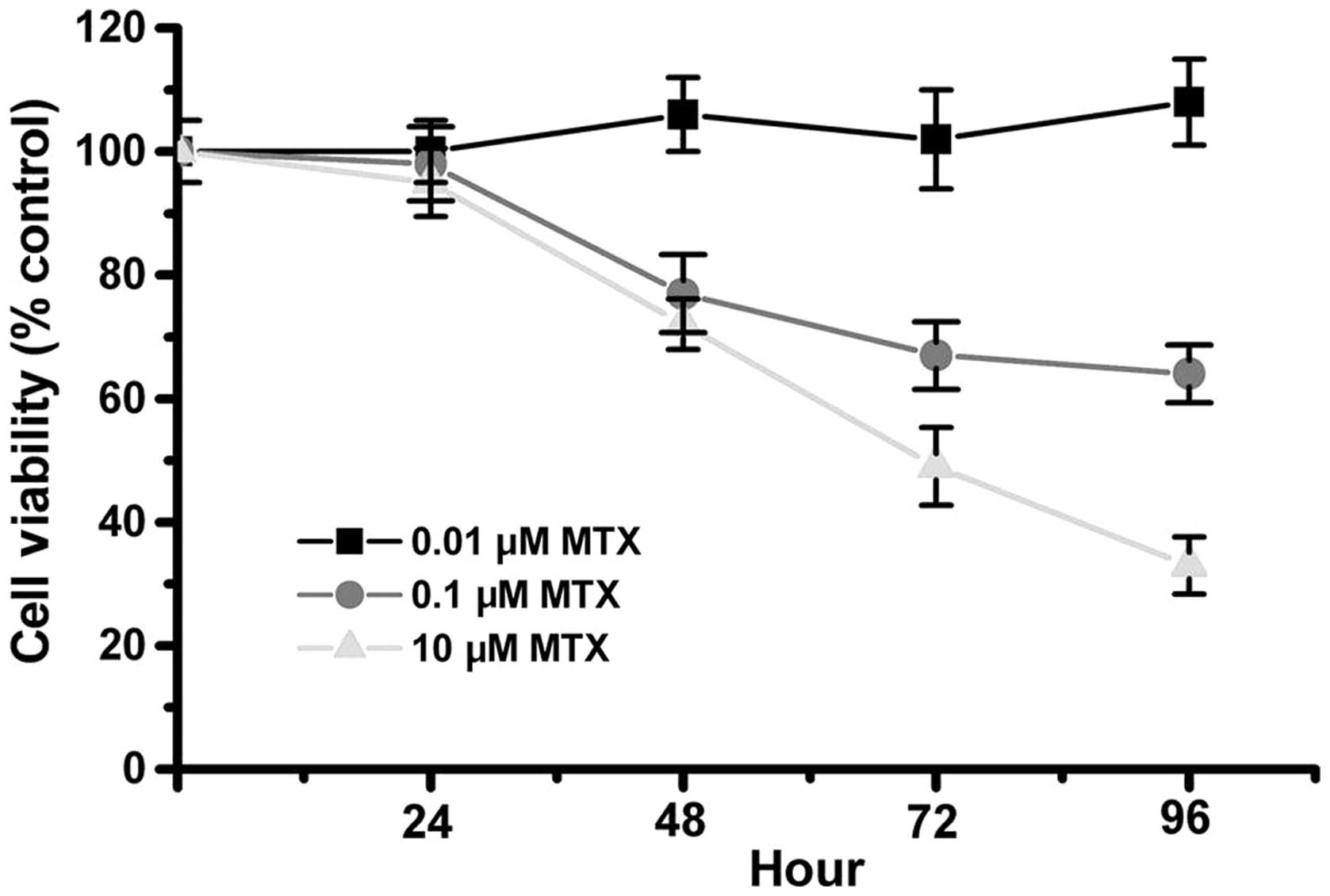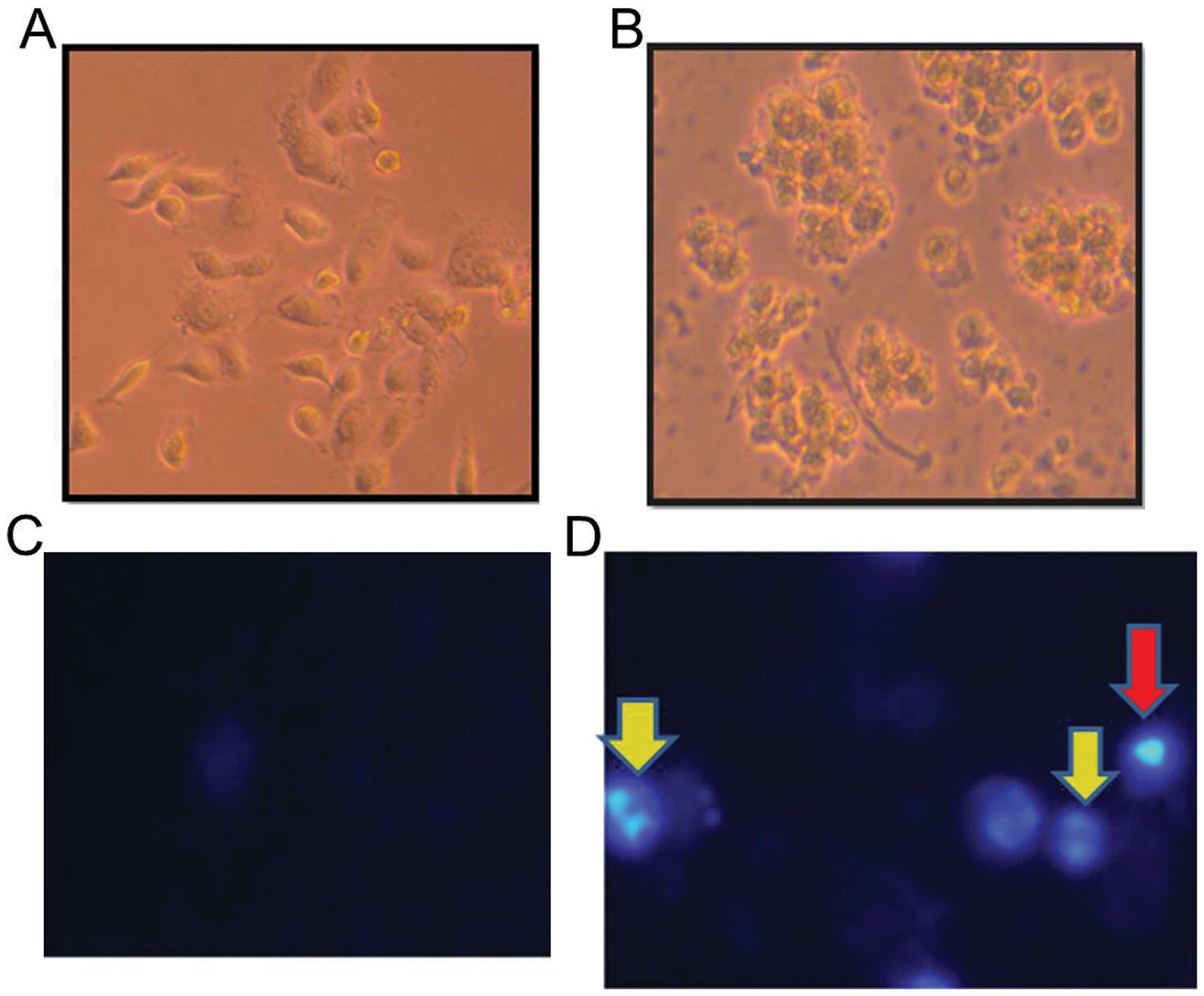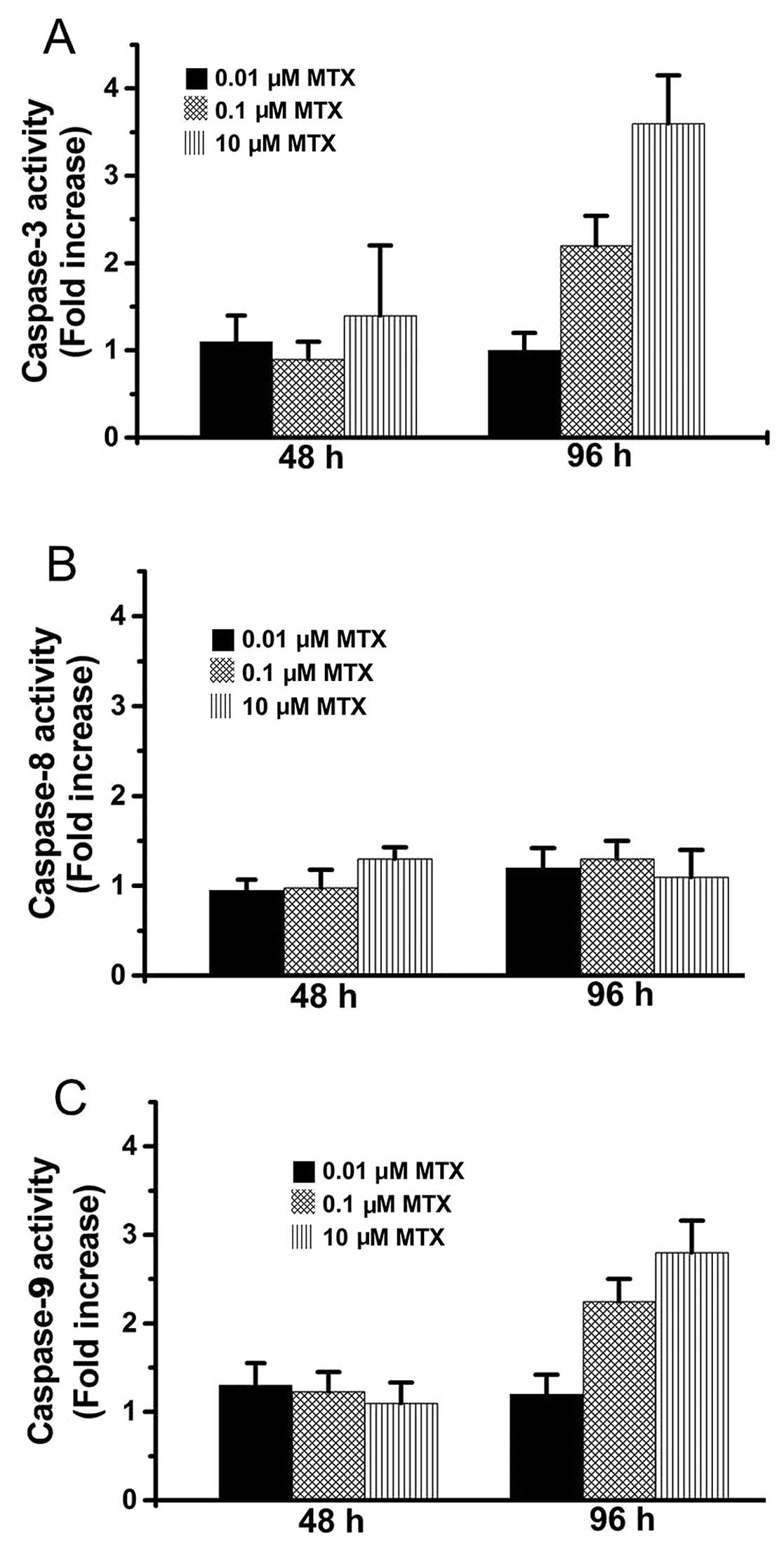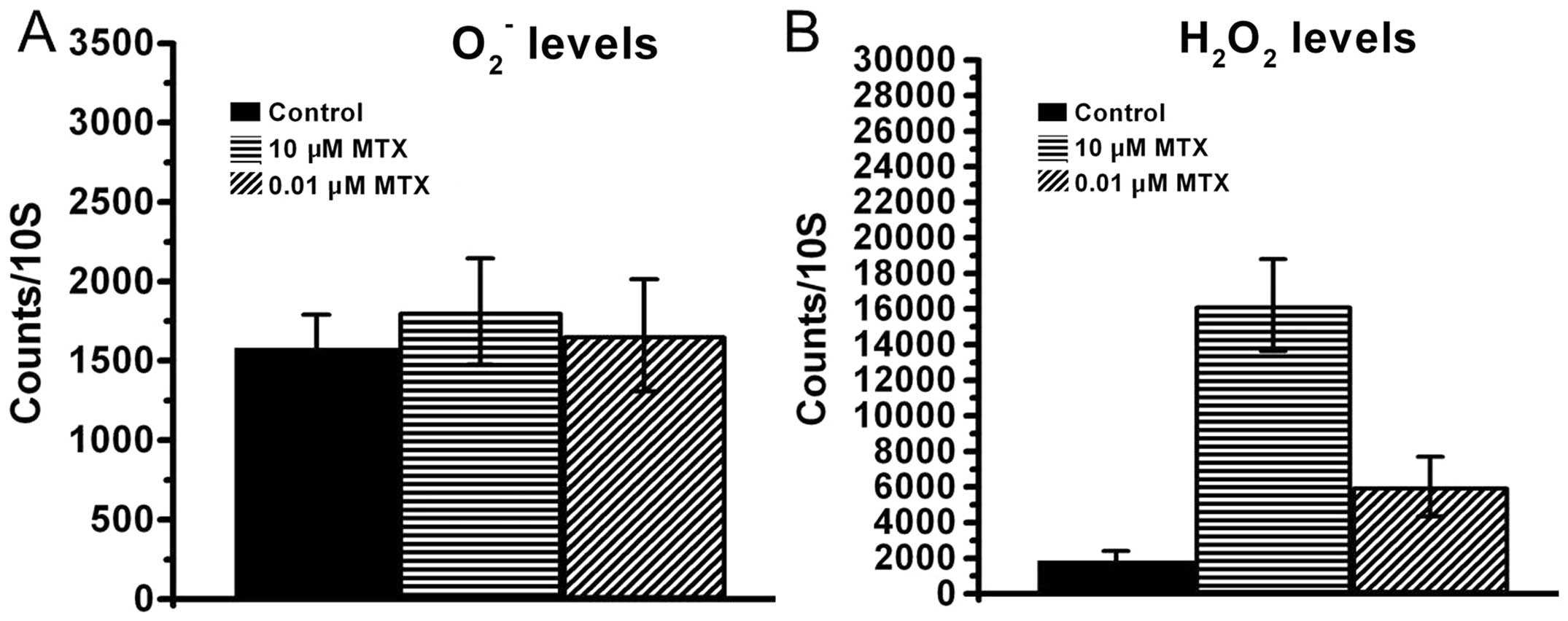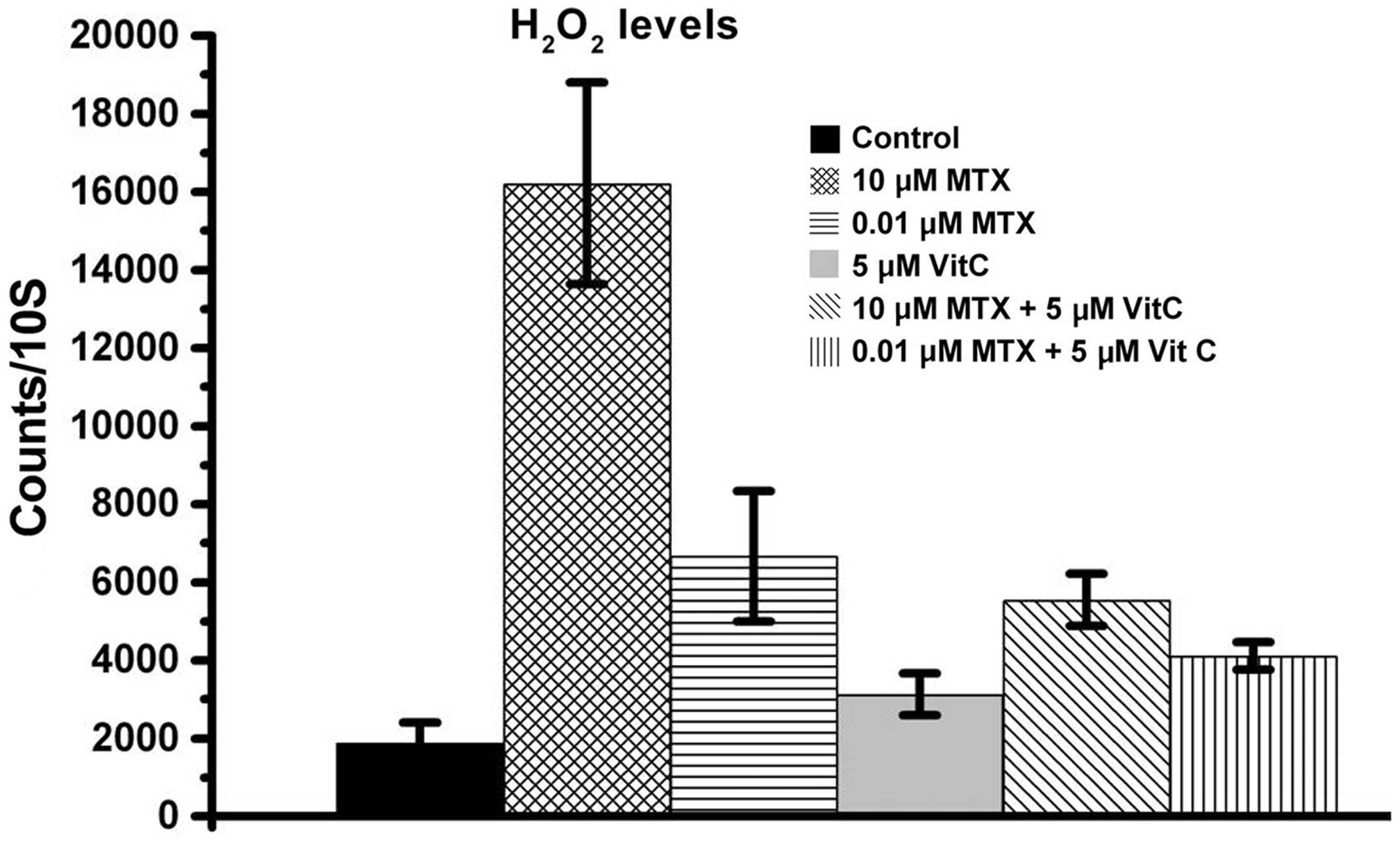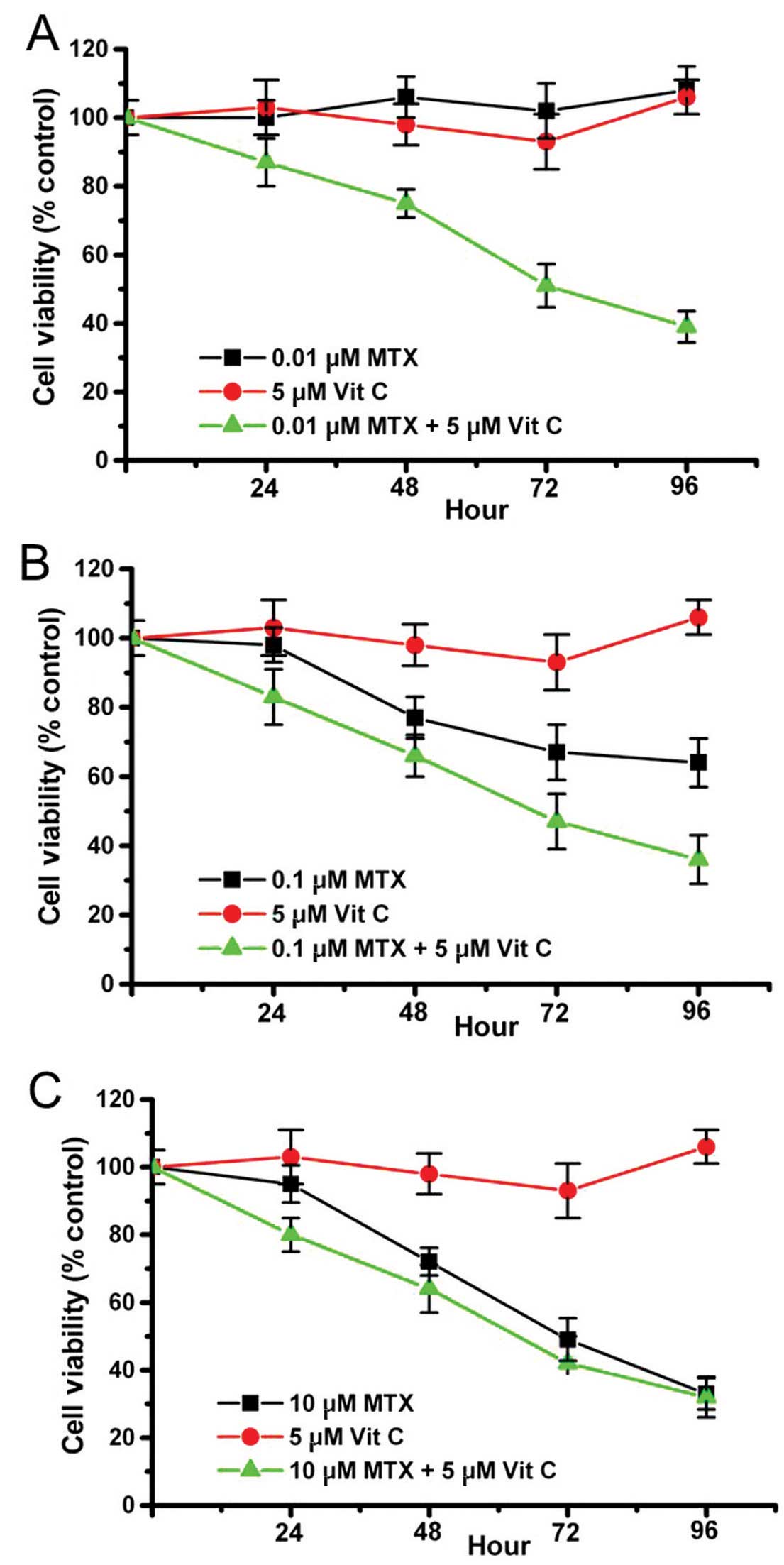Vitamin C enhances anticancer activity in methotrexate‑treated Hep3B hepatocellular carcinoma cells
- Authors:
- Published online on: June 25, 2014 https://doi.org/10.3892/or.2014.3289
- Pages: 1057-1063
Abstract
Introduction
Methotrexate (MTX) is one of the most popular and safe antirheumatic drugs under the applied treatment dose (1,2). In order to obtain a better curative effect in clinical cases, MTX is also used in combination with other drugs for rheumatoid arthritis treatment (1,3,4). In addition, MTX is also used as an anticancer drug (5). Recently, MTX has been widely applied for the treatment of various cancers, such as hepatoma, osteosarcoma, leukemia, lymphoma, gastric, breast, head and neck cancers (5–9). Many studies have demonstrated that MTX induces cancer cell death via apoptotic death pathways (10–14). Apoptotic death pathways can be divided into caspase-dependent and caspase-independent cascades (15,16). Concerning the MTX-induced apoptotic pathways, most studies have shown that MTX induces apoptosis via caspase-dependent cascades in many cancer cell lines (17–21). However, some studies have indicated that MTX can induce apoptosis via caspase-independent cascades in osteosarcoma cells (22,23). The present study found that MTX-induced apoptosis in Hep3B cells is via the caspase-dependent cascade, similar to most other studies (17–21).
Two major caspase cascade pathways have been reported (24–26). One is the caspase-8/-3 cascade, known as the extrinsic death receptor pathway (CD95/APO-1/Fas receptor) (27–29). Another is the caspase-9/-3 cascade, known as the intrinsic mitochondrial death pathway (27,30,31). Some studies have shown that MTX-induced apoptosis is mediated by the caspase-9/-3 cascade pathway in choriocarcinoma, breast cancer, oral squamous carcinoma and hepatoma cells (18,19,21,32,33). In contrast, some studies demonstrated that MTX-induced apoptosis is mediated through the caspase-8/-3 cascade pathway in breast cancer, hepatoma and leukemia cells (17,33,34). The present study showed that MTX activates the caspase-9/-3 cascade in Hep3B cells, but not the caspase-8/-3 cascade.
Previously, many studies have shown that high-dose MTX treatment can induce increased oxidative stress, resulting in renal and liver damage (3,35–37). However, the specific reactive oxygen species (ROS) induced by MTX treatment have not been identified. O2− and H2O2 are ROS families generally existing in many cells. By using the lucigenin-amplified method (38–40), our results are the first to demonstrate that MTX can induce increases in H2O2 levels, but not O2− levels.
Considering that high-dose MTX treatments can cause renal and liver damage (35–37), combination treatments of low-dose MTX and other anticancer drugs are suggested and applied during clinical cancer therapy in order to enhance the anticancer effects and decrease MTX-induced side-effects (9,10,12,18,41). However, not all anticancer agents can enhance the anticancer effects of low-dose MTX. A recent study showed that aspirin can antagonize the MTX-induced cytotoxic effect on lung cancer cells (42). Alternatively, there have been many reports on the antioxidant activities of vitamin C (43–47). Moreover, some studies have demonstrated that vitamin C can exert anticancer activities in various cancer cells (48–52). The present study demonstrated that vitamin C can diminish MTX-induced increases in H2O2 levels. On the other hand, it is worth noting that vitamin C can help low-dose MTX exert a cytotoxic effect on Hep3B cells. Taken together, the study demonstrated that MTX activates the caspase-9/-3 cascade and induces increased H2O2 levels, causing cell cytotoxicity in Hep3B cells, while more importantly, the present study is the first to demonstrate that vitamin C enhances the anticancer efficiency in MTX-treated Hep3 cells.
Materials and methods
Chemicals and materials
Methotrexate was purchased from Pfizer Inc. MTT assay kit was purchased from Bio Basic Canada Inc. Hoechst 33342, vitamin C, lucigenin and luminol were purchased from Sigma. Caspase-3 like substrate (Ac-DEVD-pNA), caspase-8 substrate (Ac-IETD-pNA) and caspase-9 substrate (Ac-LEHD-pNA) were purchased from AnaSpec, Inc. (San Jose, CA, USA). Fetal bovine serum (FBS), Dulbecco’s modified Eagle’s medium (DMEM), non-essential amino acid, L-glutamine and penicillin/streptomycin were purchased from Gibco-BRL.
Cell cultures
Hep3B cells were cultured in DMEM containing 10% FBS, 2 mM L-glutamine, 100 IU/ml penicillin/streptomycin, and 0.1 mM non-essential amino acids. The cells were cultured at 37°C in a humidified atmosphere containing 5% CO2.
Cell viability assay
Hep3B cell viability was assessed using the MTT assay method according to the manufacturer’s instructions. In brief, Hep3B cells were maintained in each well of 96-well culture plates. Every 24 h, the control group and experimental groups were subjected to the MTT assay kit. After 3 h of incubation, absorbance at 570 nm for each well containing Hep3B cells was detected under a multi-well ELISA reader (Molecular Devices). Cell viability was calculated using the following formula: A570 experimental group/A570 control group × 100%.
Nuclear condensation and DNA fragmentation
Apoptotic cells were identified by nuclear condensation and DNA fragmentation using Hoechst 33342 staining. Cells were treated with 10 μg/ml Hoechst 33342 for 10 min. Nuclear condensation and DNA fragmentation were observed under a fluorescence microscope (excitation, 352 nm; emission, 450 nm) (53,54).
Caspase activity assay
Caspase activity assays were executed according to previous studies (55,56). In brief, Hep3B cells were lysed with a lysis buffer (50 mM Tris-HCl, 120 mM NaCl, 1 mM EDTA, 1% NP-40, pH 7.5) and protease inhibitors. After centrifugation (15,000 × g, 30 min, 4°C) cell pellets were collected. The working solutions containing 40 μl cell lysates (80 μg total protein), 158 μl reaction buffer (20% glycerol, 0.5 mM EDTA, 5 mM dithiothreitol, 100 mM HEPES, pH 7.5) and 2 μl fluorogenic caspase substrate (Ac-LEHD-pNA, Ac-DEVD-pNA or Ac-IETD-pNA) were incubated at 37°C for 6 h. Fluorogenic substrate cleavage was determined at 405 nm in an ultra-microplate reader (BioTek Instruments). The fold increase in caspase activity was calculated using the following formula: (A405 experimental group - A405 control group)/A405 control group.
Determination of H2O2 and O2− levels
H2O2 and O2− levels were examined by using lucigenin-amplified chemiluminescence according to the lucigenin-amplified method (57,58). In brief, for H2O2 levels, the sample (200 μl) was mixed with 0.2 mmol/l luminol solution (100 μl). After that, the mixture was measured with a chemiluminescence analyzing system (CLA-FSI; Tohoko Electronic Industrial Co., Ltd., Miyagi, Japan) for determination. For O2− levels, 200 μl of the sample was mixed with 0.1 mmol/l of lucigenin solution (500 μl), and was then measured by the CLA-FSI chemiluminescence analyzing system.
Statistical analysis
Experimental data were calculated from three independent triplicate experiments and are presented as the mean values of the chosen triplicate groups. These experimental data are shown as means with standard deviations.
Results
MTX exerts dose-dependent and time-dependent anticancer effects on Hep3B cells
In clinical cases, 10–25 mg/week MTX (~0.1 μM/day) is a safely applied dose for rheumatoid arthritis treatment (1,2,59). In the present study, 0.1 μM (treatment-dose), 0.01 μM (low-dose) and 10 μM (high-dose) MTX were used for studying the anticancer effects on Hep3B cells. Hep3B cell viability decreased in the 0.1 and 10 μM MTX treatment groups, but did not decrease in the 0.01 μM treatment group (Fig. 1). In addition, the 10 μM MTX treatment group showed a stronger cytotoxic effect in the Hep3B cells than the 0.1 μM MTX treatment group. These data suggest that MTX exerts a dose-dependent anticancer effect on Hep3B cells. In addition, cell viability was observed over different MTX incubation times, with results showing that the cell viability decreased incrementally in the 0.1 and 10 μM MTX groups. The present study indicates that MTX exerts a dose-dependent and time-dependent anticancer effect on Hep3B cells.
MTX induces apoptosis and activates the caspase-9/-3 cascade in Hep3B cells
The study investigated whether MTX induces apoptosis in Hep3B cells. Cell morphology was observed under a phase-contrast microscope. Hep3B cells survived with morphology intact in the control group (Fig. 2A). However, dead cells were noted in the MTX treatment group (Fig. 2B). In addition, nuclear condensation and DNA fragmentation are apoptotic features and can be observed using a nuclear staining method, as previously described (55,60). Compared with the control group (Fig. 2C), nuclear condensation and DNA fragmentation were noted in the MTX-treated group (Fig. 2D). The results indicate that MTX induced apoptosis in the Hep3B cells. Next, caspase activation was determined in the MTX-treated Hep3B cells by using a substrate cleavage assay (56,61). As shown in Fig. 3A, caspase-3 activity increased in the Hep3B cells at 96 h following treatment with 0.1 and 10 μM MTX while caspase-3 activity did not increase in Hep3B cells following treatment with 0.01 μM MTX. Caspase-9 activity also increased in the 0.1 and 10 μM MTX-treated Hep3B cells at 96 h but did not increase in the 0.01 μM MTX-treated cells (Fig. 3C). However, there was no obvious increase in caspase-8 activity among the MTX-treated Hep3B cells (Fig. 3B). These results suggest that MTX (10 and 0.1 μM) induced apoptosis in the Hep3B cells via the caspase-9/-3 cascade but not via the caspase-8/-3 cascade.
MTX causes increases in H2O2 levels but not O2− levels in Hep3B cells
Previous studies have shown that MTX can cause cell cytotoxicity associated with increases in reactive oxygen species (ROS) (35–37). Prior to the present study, the literature has not yet identified which ROS is induced by MTX treatment. Both O2− and H2O2 belonging to ROS commonly exist in cells. Therefore, O2− and H2O2 levels were examined according to the lucigenin-amplified method (57,58). The present study found that MTX did not raise O2− levels in the Hep3B cells (Fig. 4A). However, both high-dose MTX and low-dose MTX raised H2O2 levels in the Hep3B cells (Fig. 4B). Therefore, the MTX-induced ROS increase is related to H2O2 levels but not related to O2− levels in the Hep3B cells.
Vitamin C reduces the increase in H2O2 levels and enhances the anticancer efficacy in MTX-treated Hep3B cells
Many studies have demonstrated that vitamin C can prevent oxidative stress-induced cell damage (43–47). Considering that MTX induces oxidative stress resulting in cell damage (35–37), this study examined whether vitamin C could decrease H2O2 levels, essentially inhibiting MTX-induced cytotoxicity in Hep3B cells. As shown in Fig. 5, the group receiving a combination treatment of vitamin C and 10 μM MTX had lower H2O2 levels than the 10 μM MTX group. Similarly, the vitamin C and 0.01 μM MTX combination treatment group had lower H2O2 levels than the 0.01 μM MTX group. These data indicate that vitamin C reduced the MTX-induced H2O2 levels. However, to our surprise, vitamin C did not attenuate cell cytotoxicity in the MTX-treated Hep3B cells. On the contrary, our data showed that vitamin C enhanced the anticancer efficacy in MTX-treated Hep3B cells (Fig. 6). As shown in Fig. 6A and B, combination treatments of 5 μM vitamin C and MTX (0.01 or 0.1 μM) exerted a stronger anticancer effect on Hep3B cells than MTX treatment alone. It is worth noting that 0.01 μM MTX alone or 5 μM vitamin C alone did not have a significant cytotoxic effect on Hep3B cells, whereas a combination treatment of 0.01 μM MTX and 5 μM vitamin C did induce a cytotoxic effect on Hep3B cells (Fig. 6A). While vitamin C did not enhance the 10 μM MTX-induced cytotoxic effect on Hep3B cells (Fig. 6C), the present study was important in indicating that vitamin C can assist low-dose MTX exert an anticancer effect on Hep3B cells.
Discussion
Previous reports have revealed that MTX-induced cytotoxicity is related to increased reactive oxygen species (ROS) (35–37). However, no study has shown which ROS are induced following MTX treatment. In the present study, two types of ROS, O2− and H2O2, were measured. H2O2 levels in MTX-treated cells rose significantly while O2− levels did not. In addition, it is well known that glutathione can convert toxic H2O2 into non-toxic H2O. We suggest that the increase in H2O2 levels is a possible and important reason why N-acetyl cysteine (NAC), a clinical drug for glutathione synthesis, is used for MTX-induced cell damage (35,38,39,62). On the other hand, high-dose MTX-induced H2O2 level increases were higher than low-dose MTX-induced H2O2 level increases (Fig. 4B). Our data also showed that MTX induced cytotoxicity in a dose-dependent manner (Fig. 1). Taken together, we consider increases in the H2O2 level to be one factor resulting in the inhibition of cell survival following MTX treatment.
MTX has anticancer effects on various hepatoma cell lines, including HepG2, MHCC97, Huh7 and Morris 5123 cells (6,63–67). Alhough the mechanisms involved in the MTX-induced cytotoxic effects on different hepatoma cells remain undetermined, a previous study demonstrated that MTX-induced cytotoxic effects on HepG2 cells are related to the CD95 death receptor pathway (caspase-8/-3 cascade pathway), whereas MTX-induced cytotoxic effects on Huh7 and Hep3B cells are not related to death receptor pathways (65). Similarly, the caspase-8/-3 cascade pathway was also found not to be involved in MTX-treated Hep3B cells in the present study (Fig. 3B). This study further demonstrated that MTX-induced apoptosis in Hep3B cells occurred through the caspase-9/-3 cascade pathway (Fig. 3A and C). These previous studies indicate that MTX induces different caspase pathways in different hepatoma cell lines. HepG2 is a p53 wild-type hepatoma cell line, while Hep3B is a p53-deficient hepatoma cell line (68,69). Thus, we suggest that p53 may be a possible reason for why the caspase-8/-3 pathway was activated in the MTX-treated HepG2 cells, while the caspase-9/-3 pathway was activated in the MTX-treated Hep3B cells.
Previous studies have demonstrated that MTX-induced cell cytotoxicity is associated with increases in reactive oxygen species (ROS) (35–37). The present study also indicated that MTX-induced H2O2 level increases may be one factor resulting in cell growth inhibition. On the other hand, vitamin C can reduce oxidative stress against ROS-induced cell damage (43–47). Here, we also demonstrated that vitamin C did reduce MTX-induced increases in H2O2 levels. However, vitamin C did not inhibit MTX-induced cell cytotoxicity in Hep3B cells. On the contrary, vitamin C assisted low-dose MTX to exhibit a strong cytotoxic effect in Hep3B cells. Similarly, recent studies also indicated that vitamin C can enhance anticancer agents to exert a strong cytotoxic effect on cancer cells, although the mechanisms remain unknown (48,70–72). Thus, MTX-induced increases in H2O2 levels may be one of the factors resulting in cytotoxicity noted in MTX-treated Hep3B cells. There are various unclear MTX-induced death signals that remain to be studied. Regardless, a combination treatment of vitamin C and low-dose MTX may be a potential method for hepatoma cancer therapy.
Overall, the present study first demonstrated that MTX induces an increase in H2O2 levels and activates the caspase-9/-3 cascade pathway to cause apoptosis in Hep3B cells. Importantly, a combination treatment of vitamin C and low-dose MTX exerted a strong anticancer effect in Hep3B cells. This treatment method may be useful for future clinical cancer therapy.
Acknowledgements
This work was supported by the following grants: NSC101-2321-B-039-004; NHRI-EX102-10245BI; TCRD-TPE-102-26 and TCRD-TPE-103-48.
References
|
Weinblatt ME: Methotrexate in rheumatoid arthritis: a quarter century of development. Trans Am Clin Climatol Assoc. 124:16–25. 2013.PubMed/NCBI | |
|
Patane M, Ciriaco M, Chimirri S, et al: Interactions among low dose of methotrexate and drugs used in the treatment of rheumatoid arthritis. Adv Pharmacol Sci. 2013:3138582013.PubMed/NCBI | |
|
Cakir T, Ozkan E, Dulundu E, et al: Caffeic acid phenethyl ester (CAPE) prevents methotrexate-induced hepatorenal oxidative injury in rats. J Pharm Pharmacol. 63:1566–1571. 2011. View Article : Google Scholar : PubMed/NCBI | |
|
Keystone E, Landewe R, van Vollenhoven R, et al: Long-term safety and efficacy of certolizumab pegol in combination with methotrexate in the treatment of rheumatoid arthritis: 5-year results from the RAPID 1 trial and open-label extension. Ann Rheum Dis. Aug 5–2013.(Epub ahead of print). View Article : Google Scholar | |
|
Cordero MD, Sanchez-Alcazar JA, Bautista-Ferrufino MR, et al: Acute oxidant damage promoted on cancer cells by amitriptyline in comparison with some common chemotherapeutic drugs. Anticancer Drugs. 21:932–944. 2010. View Article : Google Scholar : PubMed/NCBI | |
|
Otrocka M, Verschueren H and Malicka-Blaszkiewicz M: The effect of methotrexate on actin and invasiveness of hepatoma Morris 5123 cells in culture. Acta Biochim Pol. 48:1051–1060. 2001.PubMed/NCBI | |
|
Jolivet J, Cowan KH, Curt GA, Clendeninn NJ and Chabner BA: The pharmacology and clinical use of methotrexate. N Engl J Med. 309:1094–1104. 1983. View Article : Google Scholar : PubMed/NCBI | |
|
Takemura Y and Jackman AL: Folate-based thymidylate synthase inhibitors in cancer chemotherapy. Anticancer Drugs. 8:3–16. 1997. View Article : Google Scholar : PubMed/NCBI | |
|
Shirao K, Boku N, Yamada Y, et al: Randomized phase III study of 5-fluorouracil continuous infusion vs. sequential methotrexate and 5-fluorouracil therapy in far advanced gastric cancer with peritoneal metastasis (JCOG0106). Jpn J Clin Oncol. 43:972–980. 2013. View Article : Google Scholar | |
|
Chen Y, Zhang W, Gu J, et al: Enhanced antitumor efficacy by methotrexate conjugated Pluronic mixed micelles against KBv multidrug resistant cancer. Int J Pharm. 452:421–433. 2013. View Article : Google Scholar | |
|
Ding L, Hu XM, Wu H, et al: Combined transfection of Bcl-2 siRNA and miR-15a oligonucleotides enhanced methotrexate-induced apoptosis in Raji cells. Cancer Biol Med. 10:16–21. 2013.PubMed/NCBI | |
|
Florou D, Patsis C, Ardavanis A and Scorilas A: Effect of doxorubicin, oxaliplatin, and methotrexate administration on the transcriptional activity of BCL-2 family gene members in stomach cancer cells. Cancer Biol Ther. 14:587–596. 2013. View Article : Google Scholar : PubMed/NCBI | |
|
Saez-Ayala M, Montenegro MF, Sanchez-Del-Campo L, et al: Directed phenotype switching as an effective antimelanoma strategy. Cancer Cell. 24:105–119. 2013. View Article : Google Scholar : PubMed/NCBI | |
|
Yan KH, Lee LM, Hsieh MC, et al: Aspirin antagonizes the cytotoxic effect of methotrexate in lung cancer cells. Oncol Rep. 30:1497–1505. 2013.PubMed/NCBI | |
|
Ohgidani M, Komizu Y, Goto K and Ueoka R: Residual powders from Shochu distillation remnants induce apoptosis in human hepatoma cells via the caspase-independent pathway. J Biosci Bioeng. 114:104–109. 2012.PubMed/NCBI | |
|
Yu VW and Ho WS: Tetrandrine inhibits hepatocellular carcinoma cell growth through the caspase pathway and G2/M phase. Oncol Rep. 29:2205–2210. 2013.PubMed/NCBI | |
|
Fan CM, Foster BK, Hui SK and Xian CJ: Prevention of bone growth defects, increased bone resorption and marrow adiposity with folinic acid in rats receiving long-term methotrexate. PloS One. 7:e469152012. View Article : Google Scholar : PubMed/NCBI | |
|
Okamura M, Hashimoto K, Shimada J and Sakagami H: Apoptosis-inducing activity of cisplatin (CDDP) against human hepatoma and oral squamous cell carcinoma cell lines. Anticancer Res. 24:655–661. 2004.PubMed/NCBI | |
|
Papachristopoulou G, Talieri M and Scorilas A: Significant alterations in the expression pattern of kallikrein-related peptidase genes KLK4, KLK5 and KLK14 after treatment of breast cancer cells with the chemotherapeutic agents epirubicin, docetaxel and methotrexate. Tumour Biol. 34:369–378. 2013. View Article : Google Scholar | |
|
Wehner R, Bitterlich A, Meyer N, et al: Impact of chemotherapeutic agents on the immunostimulatory properties of human 6-sulfo LacNAc+(slan) dendritic cells. Int J Cancer. 132:1351–1359. 2013. View Article : Google Scholar : PubMed/NCBI | |
|
Zhang D and Loughran TP Jr: Large granular lymphocytic leukemia: molecular pathogenesis, clinical manifestations, and treatment. Hematology Am Soc Hematol Educ Program. 2012.652–659. 2012.PubMed/NCBI | |
|
Xie XB, Yin JQ, Wen LL, et al: Critical role of heat shock protein 27 in bufalin-induced apoptosis in human osteosarcomas: a proteomic-based research. PloS One. 7:e473752012. View Article : Google Scholar : PubMed/NCBI | |
|
Yang TM, Qi SN, Zhao N, et al: Induction of apoptosis through caspase-independent or caspase-9-dependent pathway in mouse and human osteosarcoma cells by a new nitroxyl spin-labeled derivative of podophyllotoxin. Apoptosis. 18:727–738. 2013. View Article : Google Scholar : PubMed/NCBI | |
|
Green DR and Reed JC: Mitochondria and apoptosis. Science. 281:1309–1312. 1998. View Article : Google Scholar : PubMed/NCBI | |
|
Thornberry NA and Lazebnik Y: Caspases: enemies within. Science. 281:1312–1316. 1998. View Article : Google Scholar : PubMed/NCBI | |
|
Tang CH, Hu CC, Wei CW and Wang JJ: Synergism of Rana catesbeiana ribonuclease and IFN-γ triggers distinct death machineries in different human cancer cells. FEBS Lett. 579:265–270. 2005. | |
|
Yaoxian W, Hui Y, Yunyan Z, Yanqin L, Xin G and Xiaoke W: Emodin induces apoptosis of human cervical cancer hela cells via intrinsic mitochondrial and extrinsic death receptor pathway. Cancer Cell Int. 13:712013. View Article : Google Scholar : PubMed/NCBI | |
|
Beaudouin J, Liesche C, Aschenbrenner S, Horner M and Eils R: Caspase-8 cleaves its substrates from the plasma membrane upon CD95-induced apoptosis. Cell Death Differ. 20:599–610. 2013. View Article : Google Scholar : PubMed/NCBI | |
|
Yu YL, Wei CW, Chen YL, Chen MH and Yiang GT: Immunotherapy of breast cancer by single delivery with rAAV2-mediated interleukin-15 expression. Int J Oncol. 36:365–370. 2010.PubMed/NCBI | |
|
Zheng B, Wu L, Ma L, et al: Telekin induces apoptosis associated with the mitochondria-mediated pathway in human hepatocellular carcinoma cells. Biol Pharm Bull. 36:1118–1125. 2013. View Article : Google Scholar | |
|
Yiang GT, Harn HJ, Yu YL, et al: Immunotherapy: rAAV2 expressing interleukin-15 inhibits HeLa cell tumor growth in mice. J Biomed Sci. 16:472009. View Article : Google Scholar : PubMed/NCBI | |
|
Chen YX, Lv WG, Chen HZ, Ye F and Xie X: Methotrexate induces apoptosis of human choriocarcinoma cell line JAR via a mitochondrial pathway. Eur J Obstet Gynecol Reprod Biol. 143:107–111. 2009. View Article : Google Scholar : PubMed/NCBI | |
|
Shiu LY, Chang LC, Liang CH, Huang YS, Sheu HM and Kuo KW: Solamargine induces apoptosis and sensitizes breast cancer cells to cisplatin. Food Chem Toxicol. 45:2155–2164. 2007. View Article : Google Scholar : PubMed/NCBI | |
|
Ehrhardt H, Wachter F, Maurer M, Stahnke K and Jeremias I: Important role of caspase-8 for chemosensitivity of ALL cells. Clin Cancer Res. 17:7605–7613. 2011. View Article : Google Scholar : PubMed/NCBI | |
|
Caglar Y, Ozgur H, Matur I, et al: Ultrastructural evaluation of the effect of N-acetylcysteine on methotrexate nephrotoxicity in rats. Histol Histopathol. 28:865–874. 2013.PubMed/NCBI | |
|
Kolli VK, Abraham P, Isaac B and Selvakumar D: Neutrophil infiltration and oxidative stress may play a critical role in methotrexate-induced renal damage. Chemotherapy. 55:83–90. 2009. View Article : Google Scholar : PubMed/NCBI | |
|
Tunali-Akbay T, Sehirli O, Ercan F and Sener G: Resveratrol protects against methotrexate-induced hepatic injury in rats. J Pharm Pharm Sci. 13:303–310. 2010.PubMed/NCBI | |
|
Ciralik H, Bulbuloglu E, Cetinkaya A, Kurutas EB, Celik M and Polat A: Effects of N-acetylcysteine on methotrexate-induced small intestinal damage in rats. Mt Sinai J Med. 73:1086–1092. 2006.PubMed/NCBI | |
|
Cetinkaya A, Kurutas EB, Bulbuloglu E and Kantarceken B: The effects of N-acetylcysteine on methotrexate-induced oxidative renal damage in rats. Nephrol Dial Transplant. 22:284–285. 2007. View Article : Google Scholar : PubMed/NCBI | |
|
Wu CS, Yen CJ, Chou RH, et al: Cancer-associated carbohydrate antigens as potential biomarkers for hepatocellular carcinoma. PloS One. 7:e394662012. View Article : Google Scholar : PubMed/NCBI | |
|
Pyrhonen S, Kuitunen T, Nyandoto P and Kouri M: Randomised comparison of fluorouracil, epidoxorubicin and methotrexate (FEMTX) plus supportive care with supportive care alone in patients with non-resectable gastric cancer. Br J Cancer. 71:587–591. 1995. View Article : Google Scholar : PubMed/NCBI | |
|
Lu Y, Sun J, Petrova K, et al: Metabolomics evaluation of the effects of green tea extract on acetaminophen-induced hepatotoxicity in mice. Food Chem Toxicol. 62:707–721. 2013. View Article : Google Scholar : PubMed/NCBI | |
|
Mukhopadhyay PK, Dey A, Mukherjee S and Pradhan NK: The effect of coadministration of α-tocopherol and ascorbic acid on arsenic trioxide-induced testicular toxicity in adult rats. J Basic Clin Physiol Pharmacol. 24:245–253. 2013. | |
|
Kim H, Bae S, Kim Y, et al: Vitamin C prevents stress-induced damage on the heart caused by the death of cardiomyocytes, through down-regulation of the excessive production of catecholamine, TNF-α, and ROS production in Gulo(−/−) mice. Free Radic Biol Med. 65C:573–583. 2013.PubMed/NCBI | |
|
Eroglu S, Pandir D, Uzun FG and Bas H: Protective role of vitamins C and E in diclorvos-induced oxidative stress in human erythrocytes in vitro. Biol Res. 46:33–38. 2013. View Article : Google Scholar : PubMed/NCBI | |
|
Murata W, Tanaka T, Kubo I and Fujita K: Protective effects of alpha-tocopherol and ascorbic acid against cardol-induced cell death and reactive oxygen species generation in Staphylococcus aureus. Planta Med. 79:768–774. 2013. View Article : Google Scholar : PubMed/NCBI | |
|
Hattiwale SH, Saha S, Yendigeri SM, Jargar JG, Dhundasi SA and Das KK: Protective effect of L-ascorbic acid on nickel induced pulmonary nitrosative stress in male albino rats. Biometals. 26:329–336. 2013. View Article : Google Scholar : PubMed/NCBI | |
|
Alexander B, Fishman AI, Eshghi M, Choudhury M and Konno S: Induction of cell death in renal cell carcinoma with combination of D-fraction and vitamin C. Integr Cancer Ther. 12:442–448. 2013. View Article : Google Scholar : PubMed/NCBI | |
|
Nagappan A, Park KI, Park HS, et al: Vitamin C induces apoptosis in AGS cells by down-regulation of 14-3-3σ via a mitochondrial dependent pathway. Food Chem. 135:1920–1928. 2012.PubMed/NCBI | |
|
Vetvicka V and Vetvickova J: Combination of glucan, resveratrol and vitamin C demonstrates strong anti-tumor potential. Anticancer Res. 32:81–87. 2012.PubMed/NCBI | |
|
Lee WJ: The prospects of vitamin C in cancer therapy. Immune Netw. 9:147–152. 2009. View Article : Google Scholar : PubMed/NCBI | |
|
Li W, Wu JX and Tu YY: Synergistic effects of tea polyphenols and ascorbic acid on human lung adenocarcinoma SPC-A-1 cells. J Zhejiang Univ Sci B. 11:458–464. 2010. View Article : Google Scholar : PubMed/NCBI | |
|
Wei CW, Lin CC, Yu YL, et al: n-Butylidenephthalide induced apoptosis in the A549 human lung adenocarcinoma cell line by coupled down-regulation of AP-2α and telomerase activity. Acta Pharmacol Sin. 30:1297–1306. 2009. View Article : Google Scholar | |
|
Yu YL, Su KJ, Chen CJ, et al: Synergistic anti-tumor activity of isochaihulactone and paclitaxel on human lung cancer cells. J Cell Physiol. 227:213–222. 2012. View Article : Google Scholar : PubMed/NCBI | |
|
Yiang GT, Chen YH, Chou PL, Chang WJ, Wei CW and Yu YL: The NS3 protease and helicase domains of Japanese encephalitis virus trigger cell death via caspase dependent and independent pathways. Mol Med Rep. 7:826–830. 2013.PubMed/NCBI | |
|
Yiang GT, Yu YL, Hu SC, Chen MH, Wang JJ and Wei CW: PKC and MEK pathways inhibit caspase-9/-3-mediated cytotoxicity in differentiated cells. FEBS Lett. 582:881–885. 2008. View Article : Google Scholar : PubMed/NCBI | |
|
Chen KH, Li PC, Lin WH, Chien CT and Low BH: Depression by a green tea extract of alcohol-induced oxidative stress and lipogenesis in rat liver. Biosci Biotechnol Biochem. 75:1668–1676. 2011. View Article : Google Scholar : PubMed/NCBI | |
|
Lin BR, Yu CJ, Chen WC, et al: Green tea extract supplement reduces D-galactosamine-induced acute liver injury by inhibition of apoptotic and proinflammatory signaling. J Biomed Sci. 16:352009. View Article : Google Scholar : PubMed/NCBI | |
|
Islam MS, Haq SA, Islam MN, et al: Comparative efficacy of subcutaneous versus oral methotrexate in active rheumatoid arthritis. Mymensingh Med J. 22:483–488. 2013.PubMed/NCBI | |
|
Yiang GT, Yu YL, Chou PL, et al: The cytotoxic protein can induce autophagocytosis in addition to apoptosis in MCF-7 human breast cancer cells. In Vivo; 26:403–409. 2012.PubMed/NCBI | |
|
Wei CW, Hu CC, Tang CH, Lee MC and Wang JJ: Induction of differentiation rescues HL-60 cells from Rana catesbeiana ribonuclease-induced cell death. FEBS Lett. 531:421–426. 2002. View Article : Google Scholar : PubMed/NCBI | |
|
Cetinkaya A, Bulbuloglu E, Kurutas EB and Kantarceken B: N-acetylcysteine ameliorates methotrexate-induced oxidative liver damage in rats. Med Sci Monit. 12:BR274–BR278. 2006.PubMed/NCBI | |
|
Chen J, Xiao XQ, Deng CM, Su XS and Li GY: Downregulation of xIAP expression by small interfering RNA inhibits cellular viability and increases chemosensitivity to methotrexate in human hepatoma cell line HepG2. J Chemother. 18:525–531. 2006. View Article : Google Scholar : PubMed/NCBI | |
|
Miller KD, Loehrer PJ, Gonin R, et al: A phase II study of weekly oral methotrexate and zidovudine (AZT) in advanced adenocarcinoma of the pancreas and hepatocellular carcinoma. Invest New Drugs. 14:207–212. 1996. View Article : Google Scholar : PubMed/NCBI | |
|
Muller M, Strand S, Hug H, et al: Drug-induced apoptosis in hepatoma cells is mediated by the CD95 (APO-1/Fas) receptor/ligand system and involves activation of wild-type p53. J Clin Invest. 99:403–413. 1997. View Article : Google Scholar : PubMed/NCBI | |
|
Wang Y, Chen H, Liu Y, et al: pH-sensitive pullulan-based nanoparticle carrier of methotrexate and combretastatin A4 for the combination therapy against hepatocellular carcinoma. Biomaterials. 34:7181–7190. 2013. View Article : Google Scholar : PubMed/NCBI | |
|
Zhao R, Hanscom M and Goldman ID: The relationship between folate transport activity at low pH and reduced folate carrier function in human Huh7 hepatoma cells. Biochim Biophys Acta. 1715:57–64. 2005. View Article : Google Scholar : PubMed/NCBI | |
|
Aden DP, Fogel A, Plotkin S, Damjanov I and Knowles BB: Controlled synthesis of HBsAg in a differentiated human liver carcinoma-derived cell line. Nature. 282:615–616. 1979. View Article : Google Scholar : PubMed/NCBI | |
|
Ponchel F, Puisieux A, Tabone E, et al: Hepatocarcinoma-specific mutant 53-249ser induces mitotic activity but has no effect on transforming growth factor β 1-mediated apoptosis. Cancer Res. 54:2064–2068. 1994.PubMed/NCBI | |
|
Held LA, Rizzieri D, Long GD, et al: A Phase I study of arsenic trioxide (Trisenox), ascorbic acid, and bortezomib (Velcade) combination therapy in patients with relapsed/refractory multiple myeloma. Cancer Invest. 31:172–176. 2013. View Article : Google Scholar | |
|
Volta V, Ranzato E, Martinotti S, et al: Preclinical demonstration of synergistic active nutrients/drug (AND) combination as a potential treatment for malignant pleural mesothelioma. PloS One. 8:e580512013. View Article : Google Scholar : PubMed/NCBI | |
|
Vuyyuri SB, Rinkinen J, Worden E, Shim H, Lee S and Davis KR: Ascorbic acid and a cytostatic inhibitor of glycolysis synergistically induce apoptosis in non-small cell lung cancer cells. PloS One. 8:e670812013. View Article : Google Scholar : PubMed/NCBI |



